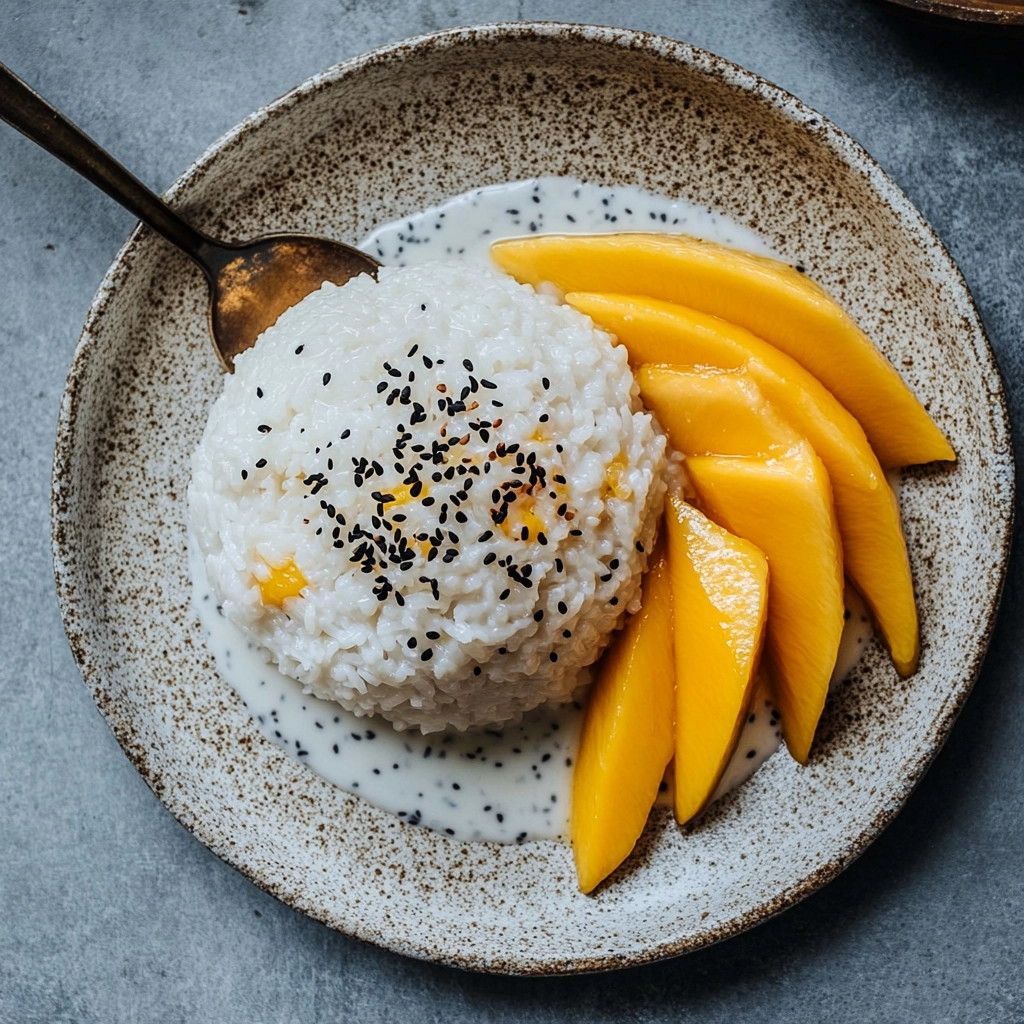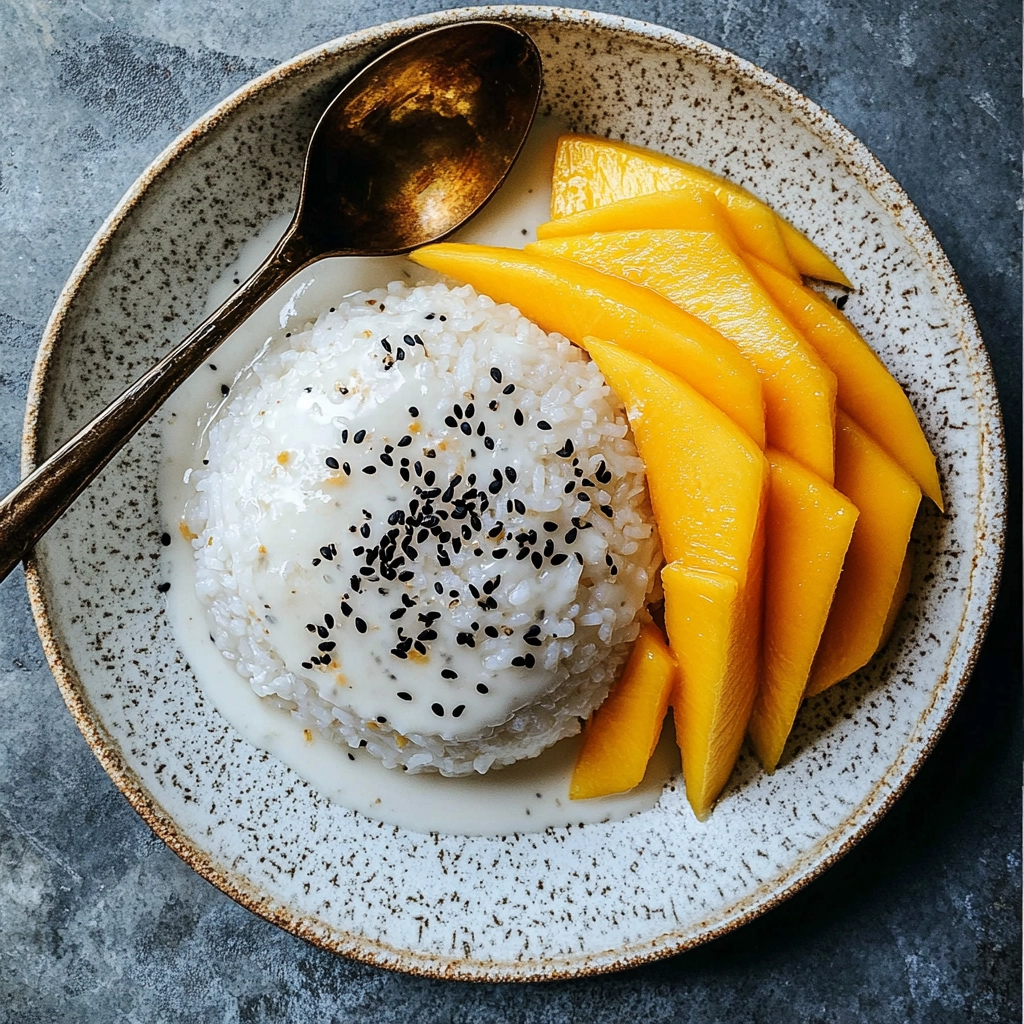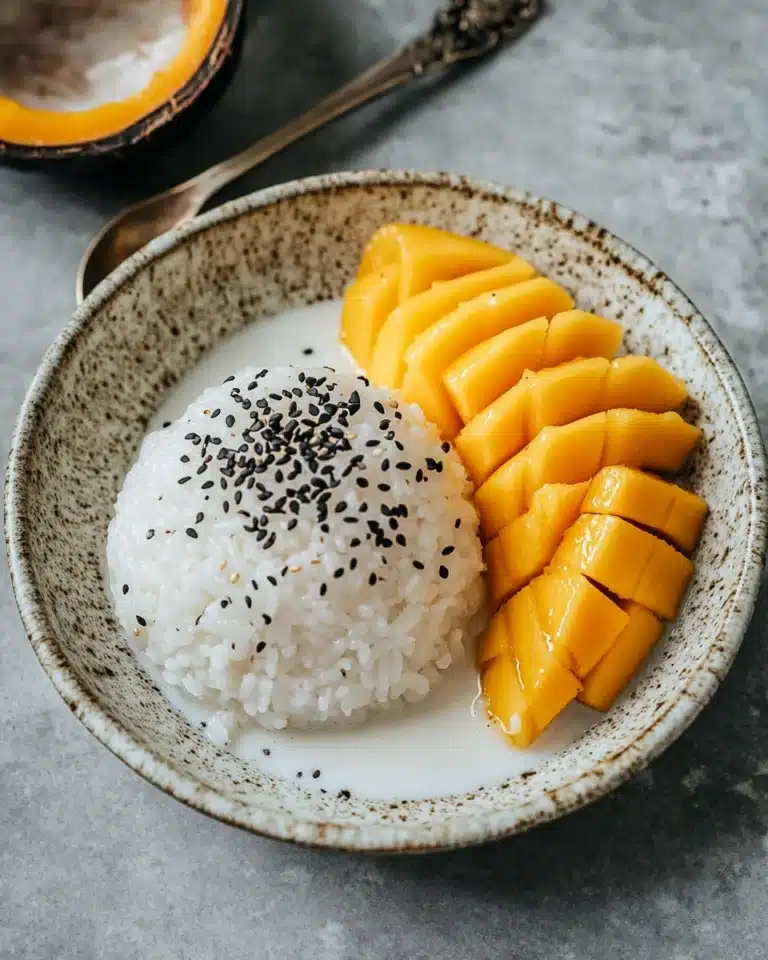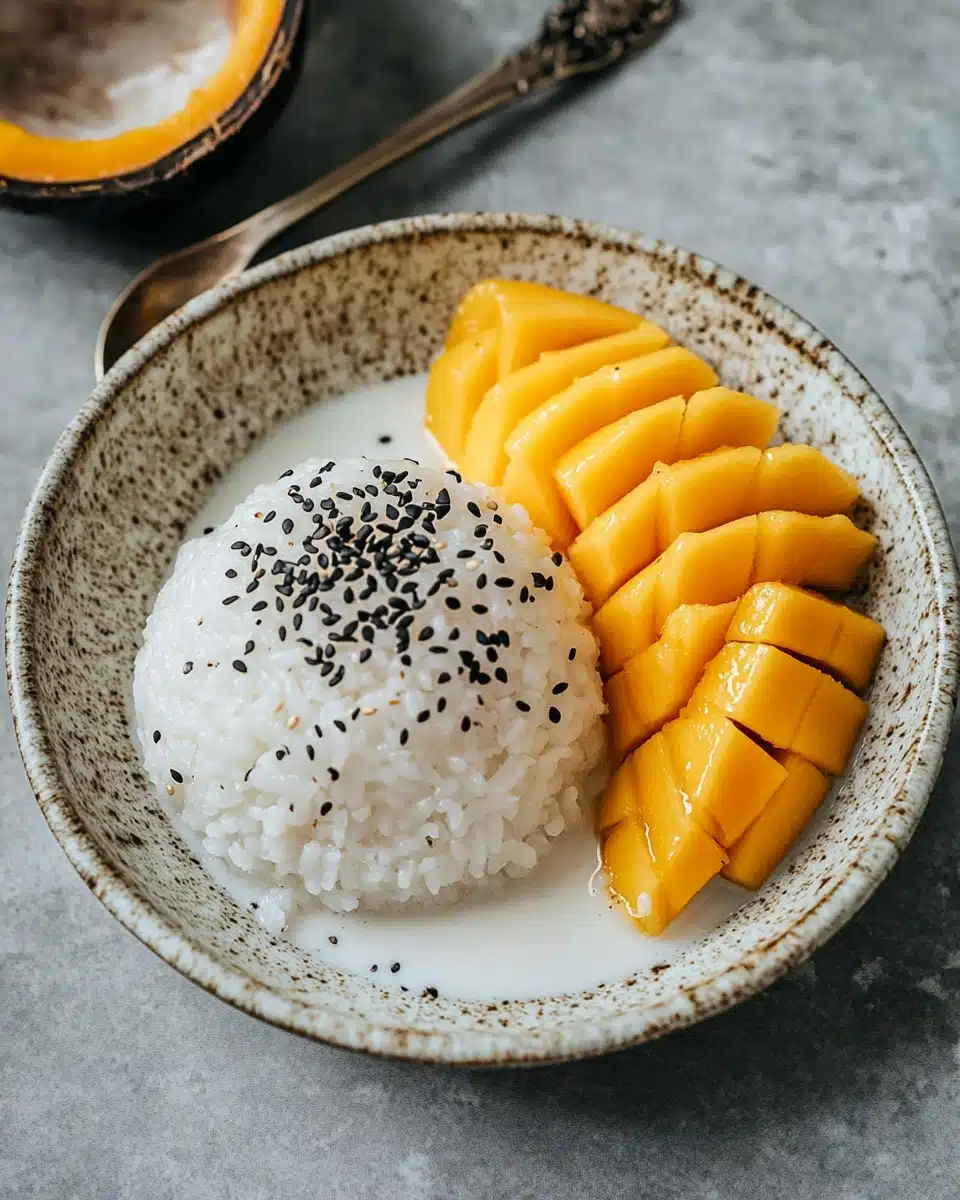Few desserts capture the sheer delight of summer quite like Mango Sticky Rice. This beloved Thai sweet treat pairs aromatic sticky rice with slices of perfectly ripe mango and a glossy, sweet coconut sauce. It’s naturally gluten-free, simple to prepare at home, and absolutely irresistible—the kind of dessert that disappears in minutes, leaving everyone reaching for seconds. Each bite is a celebration of contrast and harmony: creamy meets juicy, tropical aroma meets gentle sweetness, and every spoonful feels uplifting. Whether you’re making Mango Sticky Rice for a party or just to treat yourself after dinner, prepare to be swept away by its sunshine-bright flavors.

Ingredients You’ll Need
The beauty of Mango Sticky Rice is how few, yet how essential, its ingredients are! Every component, from the sticky rice to the juicy mangoes, plays a starring role in bringing the dish’s vibrant flavor and creamy texture to life.
- Sticky rice (1 cup, uncooked): This glutinous rice absorbs the coconut sauce beautifully, becoming chewy and tender—be sure not to substitute with regular rice!
- Full-fat coconut milk (1 can, 13.5 oz / 400 g): Don’t skimp on fat here; this is what gives Mango Sticky Rice its rich, luscious taste and creamy mouthfeel.
- Sugar (1/4 cup): Just the right amount to sweeten the sauce and balance the tartness of the mangoes without overpowering them.
- Salt (1/2 teaspoon): Salt may seem surprising in a dessert, but it lifts all the flavors and makes the coconut pop.
- Cornstarch (2 teaspoons, optional): If your coconut milk is on the runny side, this will thicken the sauce to just the right consistency.
- Ripe mangoes (3, peeled and sliced): Go for the juiciest, sweetest mangoes you can find—they’re what make this dish unforgettable.
- Toasted sesame seeds (optional, for garnish): A sprinkle on top adds subtle crunch and an extra layer of nutty aroma.
How to Make Mango Sticky Rice
Step 1: Soak and Rinse the Sticky Rice
Don’t rush this step! Rinsing the sticky rice helps remove excess starch, so your finished rice won’t be gluey or heavy. Soak the rice for at least an hour (overnight is even better) to soften the grains and guarantee that signature chewy, sticky texture we all adore.
Step 2: Steam the Sticky Rice
Transfer your soaked rice to a heatproof bowl and steam it over simmering water for about 20 to 25 minutes. Steaming (rather than boiling) is traditional and results in every grain being tender but distinct—no mushy mess! While it cooks, let anticipation build: your kitchen will soon be filled with the faintly sweet aroma of rice.
Step 3: Prepare the Coconut Sauce
While your rice steams, gently heat coconut milk with sugar and salt in a saucepan. You want the sugar to dissolve completely, but don’t let it boil—a gentle heat is key for a smooth, glossy sauce. If you notice your coconut milk is a bit thin, whisk the cornstarch with water first and gradually add it, ensuring the sauce lightly coats the back of a spoon but isn’t too thick.
Step 4: Combine Rice and Coconut Sauce
With oven mitts (trust me—the bowl will be hot!), carefully remove the cooked sticky rice from your steamer. Immediately pour about a cup of the warm coconut sauce over the rice and stir gently. The rice will absorb the sauce as it cools, soaking up all that tropical richness.
Step 5: Cool and Plate
Let the rice and the extra coconut sauce cool to room temperature or a gentle lukewarm. To assemble each serving, scoop some coconut-infused sticky rice onto small plates or bowls, then fan out those gorgeous mango slices on the side. Drizzle with a little more of that glossy coconut sauce—don’t be shy!
How to Serve Mango Sticky Rice

Mango Sticky Rice Garnishes
A classic garnish is a sprinkle of toasted sesame seeds, which adds aromatic crunch and a pretty visual touch. Some people like to scatter a few mung beans or shredded coconut on top for added color and texture. Always finish with a final drizzle of coconut sauce, letting it pool around the sticky rice for that tempting, creamy finish.
Side Dishes
Mango Sticky Rice is perfectly satisfying all on its own, but if you’re serving a bigger Thai-inspired meal, consider fresh fruit on the side or light green tea for a refreshing palate cleanser. Sometimes, a tiny side of tart passion fruit or dragon fruit is a lovely contrast.
Creative Ways to Present
Why not have a little fun with presentation? Try layering sticky rice and mango in parfait glasses for a stunning dessert, or use small molds to shape the rice into neat rounds. For parties, you can make mini portions in shot glasses, perfect for easy sharing—a guaranteed crowd-pleaser!
Make Ahead and Storage
Storing Leftovers
Leftover Mango Sticky Rice will keep beautifully in an airtight container in the refrigerator for up to 3 days. Just remember to store the coconut sauce and the rice separately from the sliced mango to preserve freshness and texture.
Freezing
While you can freeze the sticky rice and coconut sauce separately (wrap the rice tightly to prevent freezer burn), it’s best to add fresh mango after thawing. Frozen mango changes texture and just doesn’t shine the same way atop the delicately chewy rice.
Reheating
To reheat, gently steam or microwave the sticky rice with a splash of water to restore its soft, sticky texture—cover loosely with a damp paper towel for best results. Warm the coconut sauce separately, then assemble with fresh mango right before serving.
FAQs
Can I use regular rice instead of sticky rice?
For authentic Mango Sticky Rice, glutinous (sweet) rice is absolutely critical—the texture and chew just can’t be matched by jasmine or regular rice. If you can’t find it at your local store, check Asian groceries or online.
Is there a substitute for coconut milk?
Coconut milk is an integral part of Mango Sticky Rice, but if needed, you can swap in a creamy oat or cashew milk for a different twist. However, you’ll miss that luscious, signature coconut flavor.
What kind of mango works best?
Go for mangoes at their peak—Ataulfo (honey) mangoes are particularly creamy and sweet, but any varietal that’s supple, fragrant, and almost meltingly soft will do wonders for this recipe.
How do I prevent my sticky rice from being too wet or mushy?
Soaking and draining thoroughly before steaming, and resisting the urge to add too much liquid, are your secrets to perfectly textured sticky rice. Always check for doneness before adding the coconut sauce.
Can I make Mango Sticky Rice ahead for a party?
Absolutely! Prep the components the day before, then reheat and assemble just before serving. It’s a perfect make-ahead dessert that actually gets creamier as it sits.
Final Thoughts
If you’ve never made Mango Sticky Rice at home before, there’s no better time to start—it’s a sunshiney treat that brightens up any day. Each bite is a simple reminder of how magical the combination of rice, coconut, and mango can be, and I hope you’ll find yourself coming back to this recipe again and again. Enjoy every sweet, creamy, fragrant bite!
Print
Mango Sticky Rice
Mango Sticky Rice is a classic Thai dessert that pairs luxuriously tender, sweet sticky rice with creamy coconut sauce and fresh, juicy mango slices. Naturally gluten-free and vegan, this easy homemade version uses less sugar than takeout but delivers the same satisfying tropical flavors and luscious textures.
- Total Time: 1 hour 40 minutes
- Yield: 4 to 6 servings
Ingredients
For the Sticky Rice
- 1 cup uncooked sticky (glutinous) rice
For the Coconut Sauce
- 1 can full-fat coconut milk (13.5 oz / 400 g)
- 1/4 cup sugar
- 1/2 teaspoon salt
- 2 teaspoons cornstarch (optional, for thickening)
For Serving
- 3 ripe mangoes, peeled and sliced
- Toasted sesame seeds (optional, for garnish)
Instructions
- Soak the Rice: Rinse the sticky rice with tap water, gently stirring by hand. Drain and repeat once more to remove excess starch. Cover with cold water and soak for at least 1 hour or overnight in the fridge. After soaking, rinse and drain again.
- Steam the Rice: Transfer the rice to a heatproof bowl. Add about 2 inches of water to your steamer (ensure water does not touch the rice), place the rice bowl on the steaming rack, and cover. Bring water to a boil on medium-high, then reduce to medium when steam emerges. Steam for 20–25 minutes until the rice is fully cooked and no raw bits remain. Leave covered off the heat while you prepare the sauce.
- Make the Coconut Sauce: While the rice cooks, add coconut milk, sugar, and salt to a saucepan. Cook over medium or medium-low heat, stirring, until the sugar dissolves and the mixture is hot. Do not let it boil.
- Thicken the Sauce (If Needed): If the coconut milk is thin, mix the cornstarch with 4 tablespoons water to make a slurry. Add half of the slurry to the hot coconut sauce, stirring to thicken. Adjust thickness as needed—the sauce should coat the back of a spoon but not be too thick.
- Combine Rice and Sauce: Carefully remove the steamed rice bowl. Pour 1 cup of coconut sauce over the rice and stir well until absorbed.
- Cool and Serve: Let the coconut rice and sauce cool to room temperature or lukewarm. To serve, place about 1/3 cup of coconut rice on small bowls or plates, add sliced mango on the side, spoon extra coconut sauce on top, and garnish with toasted sesame seeds if desired.
Notes
- Most full-fat coconut milk is creamy enough and may not require cornstarch. Use it only if your coconut milk is thin or you prefer a thicker sauce.
- For a dessert-sized portion, use about 1/3 cup rice and half a mango per serving. For a larger snack, increase to 1/2 cup rice per person (makes 4 generous servings).
- Mango Sticky Rice is best served slightly warm or at room temperature. Leftovers can be refrigerated, but the rice may harden—gently re-steam or microwave to soften.
- Use the ripest, sweetest mangoes for the best flavor contrast with the creamy rice.
- Prep Time: 10 minutes (plus 1 hour soaking)
- Cook Time: 30 minutes
- Category: Desserts
- Method: Steaming
- Cuisine: Thai
- Diet: Vegan
Nutrition
- Serving Size: 1 serving
- Calories: 288 kcal
- Sugar: 24.9 g
- Sodium: 276 mg
- Fat: 12.9 g
- Saturated Fat: 11.1 g
- Unsaturated Fat: 1.8 g
- Trans Fat: 0 g
- Carbohydrates: 42.4 g
- Fiber: 2.8 g
- Protein: 3.1 g
- Cholesterol: 0 mg

